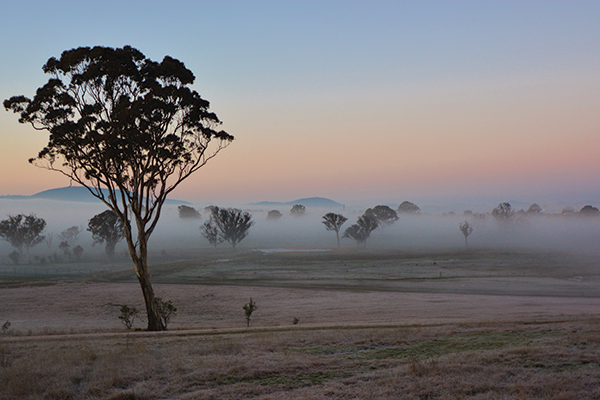Yellow Box-Blakely’s Red Gum Woodland
 The distribution of Yellow Box–Blakely's Red Gum woodland in the ACT has declined by about 66% since 1750. Yellow Box–Blakely's Red Gum Grassy Woodland was declared an endangered ecological community in the ACT in 1997 under the Nature Conservation Act 1980. It is classified as an endangered ecological community as part of the federally listed, critically endangered White Box–Yellow Box–Blakely's Red Gum Grassy Woodland and as endangered in NSW.
The distribution of Yellow Box–Blakely's Red Gum woodland in the ACT has declined by about 66% since 1750. Yellow Box–Blakely's Red Gum Grassy Woodland was declared an endangered ecological community in the ACT in 1997 under the Nature Conservation Act 1980. It is classified as an endangered ecological community as part of the federally listed, critically endangered White Box–Yellow Box–Blakely's Red Gum Grassy Woodland and as endangered in NSW.
The Yellow Box–Blakely's Red Gum Woodland community features trees of medium height (10–35 metres) with separated canopies and foliage cover of 4–30%. The woodland is dominated by Yellow Box, Blakely's Red Gum, Apple Box and Candlebark. It has a rich understorey of native tussock grasses, herbs and scattered shrubs.
The woodland provides important habitat for a range of plants and animals, including 18 rare and threatened species. In particular, nature reserves at Mulligans Flat, Goorooyarroo, the lower slopes of Mount Ainslie, Callum Brae, Kinlyside and Dunlop provide critical habitat for threatened species. The woodland occurs across land managed by the ACT Government, the Australian Government and private land holders.
Conservation threats
Most of the remaining woodland in the ACT is in the northern half of the Territory. The key threats include urbanisation, inappropriate grazing and fire regimes, invasive plants, pest animals and climate change.
Urbanisation can impact the woodland through habitat modification (e.g. firewood and rock removal), poaching (i.e. illegal plant and animal collection), nutrient enrichment (e.g. urban run-off), pollution (e.g. noise, light), predators and competitors.
Inappropriate grazing can cause significant disruption to plant communities, animal habitat and ecosystems. Frequent fires impact on woodland ecosystems by reducing the density and viability of native plant communities and destroying ground layers like fallen timber and leaf litter. Severe fires can kill native vegetation, including the bigger trees.
Invasive plants that threaten the woodland include exotic grasses (e.g. Chilean Needlegrass, Serrated Tussock and African Lovegrass), exotic forbs (e.g. St John’s Wort and Paterson’s Curse) exotic shrubs (e.g. Blackberry) and native invasive scrub (e.g. Cootamundra Wattle).
Pest animals include over-abundant and introduced herbivores (e.g. Eastern Grey Kangaroos and European Rabbits), introduced predators (e.g. European Red Foxes and feral cats), introduced competitors (e.g. Common Mynas and Common Starlings) and native competitors (e.g. Noisy Miners and Rainbow Lorikeets).
The predicted impacts of climate change in the ACT include increased maximum temperatures, prolonged drought, reduced soil moisture, increased intensity of heavy rainfall events, and harsher fire weather. Climate change is likely to alter the structure and floristic composition of the woodland and compromise the resilience of grassy woodland communities.
Conservation objectives
- Protect remaining areas of endangered Yellow Box–Blakely's Red Gum Woodland from unintended impacts.
- Maintain the ecological values of endangered Yellow Box–Blakely's Red Gum Woodland to promote ecosystem function and prevent biodiversity loss, including maintaining:
- understorey structural and floristic diversity
- optimal habitat for threatened species, including keystone structures.
- Improve the condition and ecological function of endangered Yellow Box–Blakely's Red Gum Woodland by undertaking restoration.
- Improve understanding of endangered Yellow Box–Blakely's Red Gum Woodland ecology, restoration principles and best practice threat management.
- Strengthen stakeholder and community collaboration in the conservation of endangered Yellow Box–Blakely's Red Gum Woodland.
Under the Commonwealth's Environmental Protection Biodiversity Conservation (EPBC) Act 1999, the ACT Government is committed to assess the impacts of development on any endangered woodland that is slated for development and to provide offset areas if required. Offset areas are managed for conservation, often leading to improved biodiversity outcomes. Thirteen offset areas have been created in the last ten years.
Conservation actions
Since the first action plan, much has been done to improve our woodlands, including research, revegetation, understorey rehabilitation and structural enhancement. Actions in the new action plan to support the conservation of the Yellow Box–Blakely's Red Gum Woodland community in the ACT include:
- protecting all endangered Yellow Box–Blakely's Red Gum Woodland from unintended impacts, including those areas that make a significant contribution to the woodland community and/or contain rare or threatened species
- maintaining ecological and evolutionary processes by implementing appropriate grazing and fire management regimes
- creating optimal stand densities and maintaining diverse age structure, which is critical to sustaining woodland biodiversity
- evaluating the conservation outcomes of grazing by different herbivore species
- monitoring dieback and supporting projects that improve our understanding of the causes of dieback
- undertaking research projects that improve understanding of the impacts of climate change
- working with traditional custodians to undertake woodland management
- facilitating community participation in woodland conservation and raising community awareness.
More information
Contact
Email environment@act.gov.au or phone Access Canberra on 13 22 81.

